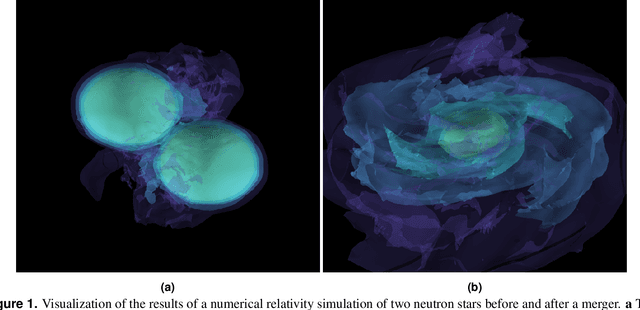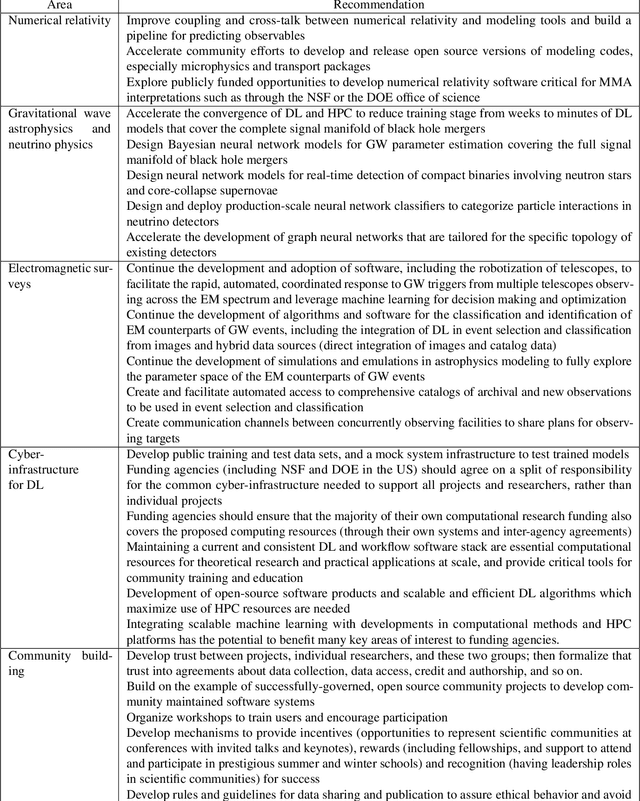Roland Haas
AI-driven Conservative-to-Primitive Conversion in Hybrid Piecewise Polytropic and Tabulated Equations of State
Dec 10, 2024Abstract:We present a novel AI-based approach to accelerate conservative-to-primitive inversion in relativistic hydrodynamics simulations, focusing on hybrid piecewise polytropic and tabulated equations of state. Traditional root-finding methods are computationally intensive, particularly in large-scale simulations. To address this, we employ feedforward neural networks (NNC2PS and NNC2PL), trained in PyTorch and optimized for GPU inference using NVIDIA TensorRT, achieving significant speedups with minimal loss in accuracy. The NNC2PS model achieves $L_1$ and $L_\infty$ errors of $4.54 \times 10^{-7}$ and $3.44 \times 10^{-6}$, respectively, with the NNC2PL model yielding even lower error values. TensorRT optimization ensures high accuracy, with FP16 quantization offering 7x faster performance than traditional root-finding methods. Our AI models outperform conventional CPU solvers, demonstrating enhanced inference times, particularly for large datasets. We release the scientific software developed for this work, enabling the validation and extension of our findings. These results highlight the potential of AI, combined with GPU optimization, to significantly improve the efficiency and scalability of numerical relativity simulations.
SciCode: A Research Coding Benchmark Curated by Scientists
Jul 18, 2024



Abstract:Since language models (LMs) now outperform average humans on many challenging tasks, it has become increasingly difficult to develop challenging, high-quality, and realistic evaluations. We address this issue by examining LMs' capabilities to generate code for solving real scientific research problems. Incorporating input from scientists and AI researchers in 16 diverse natural science sub-fields, including mathematics, physics, chemistry, biology, and materials science, we created a scientist-curated coding benchmark, SciCode. The problems in SciCode naturally factorize into multiple subproblems, each involving knowledge recall, reasoning, and code synthesis. In total, SciCode contains 338 subproblems decomposed from 80 challenging main problems. It offers optional descriptions specifying useful scientific background information and scientist-annotated gold-standard solutions and test cases for evaluation. Claude3.5-Sonnet, the best-performing model among those tested, can solve only 4.6% of the problems in the most realistic setting. We believe that SciCode demonstrates both contemporary LMs' progress towards becoming helpful scientific assistants and sheds light on the development and evaluation of scientific AI in the future.
APACE: AlphaFold2 and advanced computing as a service for accelerated discovery in biophysics
Aug 15, 2023Abstract:The prediction of protein 3D structure from amino acid sequence is a computational grand challenge in biophysics, and plays a key role in robust protein structure prediction algorithms, from drug discovery to genome interpretation. The advent of AI models, such as AlphaFold, is revolutionizing applications that depend on robust protein structure prediction algorithms. To maximize the impact, and ease the usability, of these novel AI tools we introduce APACE, AlphaFold2 and advanced computing as a service, a novel computational framework that effectively handles this AI model and its TB-size database to conduct accelerated protein structure prediction analyses in modern supercomputing environments. We deployed APACE in the Delta supercomputer, and quantified its performance for accurate protein structure predictions using four exemplar proteins: 6AWO, 6OAN, 7MEZ, and 6D6U. Using up to 200 ensembles, distributed across 50 nodes in Delta, equivalent to 200 A100 NVIDIA GPUs, we found that APACE is up to two orders of magnitude faster than off-the-shelf AlphaFold2 implementations, reducing time-to-solution from weeks to minutes. This computational approach may be readily linked with robotics laboratories to automate and accelerate scientific discovery.
Enabling real-time multi-messenger astrophysics discoveries with deep learning
Nov 26, 2019

Abstract:Multi-messenger astrophysics is a fast-growing, interdisciplinary field that combines data, which vary in volume and speed of data processing, from many different instruments that probe the Universe using different cosmic messengers: electromagnetic waves, cosmic rays, gravitational waves and neutrinos. In this Expert Recommendation, we review the key challenges of real-time observations of gravitational wave sources and their electromagnetic and astroparticle counterparts, and make a number of recommendations to maximize their potential for scientific discovery. These recommendations refer to the design of scalable and computationally efficient machine learning algorithms; the cyber-infrastructure to numerically simulate astrophysical sources, and to process and interpret multi-messenger astrophysics data; the management of gravitational wave detections to trigger real-time alerts for electromagnetic and astroparticle follow-ups; a vision to harness future developments of machine learning and cyber-infrastructure resources to cope with the big-data requirements; and the need to build a community of experts to realize the goals of multi-messenger astrophysics.
* Invited Expert Recommendation for Nature Reviews Physics. The art work produced by E. A. Huerta and Shawn Rosofsky for this article was used by Carl Conway to design the cover of the October 2019 issue of Nature Reviews Physics
Deep Learning for Multi-Messenger Astrophysics: A Gateway for Discovery in the Big Data Era
Feb 01, 2019Abstract:This report provides an overview of recent work that harnesses the Big Data Revolution and Large Scale Computing to address grand computational challenges in Multi-Messenger Astrophysics, with a particular emphasis on real-time discovery campaigns. Acknowledging the transdisciplinary nature of Multi-Messenger Astrophysics, this document has been prepared by members of the physics, astronomy, computer science, data science, software and cyberinfrastructure communities who attended the NSF-, DOE- and NVIDIA-funded "Deep Learning for Multi-Messenger Astrophysics: Real-time Discovery at Scale" workshop, hosted at the National Center for Supercomputing Applications, October 17-19, 2018. Highlights of this report include unanimous agreement that it is critical to accelerate the development and deployment of novel, signal-processing algorithms that use the synergy between artificial intelligence (AI) and high performance computing to maximize the potential for scientific discovery with Multi-Messenger Astrophysics. We discuss key aspects to realize this endeavor, namely (i) the design and exploitation of scalable and computationally efficient AI algorithms for Multi-Messenger Astrophysics; (ii) cyberinfrastructure requirements to numerically simulate astrophysical sources, and to process and interpret Multi-Messenger Astrophysics data; (iii) management of gravitational wave detections and triggers to enable electromagnetic and astro-particle follow-ups; (iv) a vision to harness future developments of machine and deep learning and cyberinfrastructure resources to cope with the scale of discovery in the Big Data Era; (v) and the need to build a community that brings domain experts together with data scientists on equal footing to maximize and accelerate discovery in the nascent field of Multi-Messenger Astrophysics.
 Add to Chrome
Add to Chrome Add to Firefox
Add to Firefox Add to Edge
Add to Edge